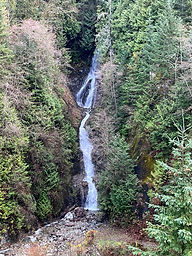Want to Join the Butterflyway?
- kc dyer

- Apr 25, 2024
- 2 min read
Making local pollinators feel welcome
Back in November, local gardeners Val Morton and Hana Boye wrote to notify Council of the recent achievement of 'Butterflyway' certification from the David Suzuki Foundation.
In order to be certified, there must be 12 or more butterfly (pollinator) gardens connected within a small area, with the goal of creating a country-wide corridor for pollinators. Val noted that Lions Bay had 15 such gardens, and that the team were hoping to add more in 2024. She said that being part of a butterflyway is significant because "it helps to protect our native ecosystem and it also raises awareness within the village of the importance of nurturing native biodiversity."
Interested in taking part? Now's the time!
According to Val, almost 90% of flowering plants need pollinators to reproduce, so bees and other pollinators are important for ecosystem stability. Of the more than 450 species of bee in BC, the most common include: bumble bees, sweat bees, mining bees and hairy-belly bees. Like all species at risk of extinction, the number one threat to butterflies and bees is habitat loss. Native plants that support and protect our local pollinators can enhance biodiversity and restore disrupted ecosystems, which benefits all life.
Hana talks about encouraging pollinators in local gardens:
Like all animals, pollinators need two basic things: food and a place to nest. It's important to select plants that provide pollinators with food sources throughout the year and for all stages of life, including caterpillars (butterfly larvae). Many butterflies require plants that bloom throughout the growing season, so nectar is always available.
Though nectar is one of the main sources of nutrients for butterflies, the Canadian Wildlife Foundation notes that many butterflies get nutrients from damp sand, compost and manure, as well as from tree sap, rotting fruit, dung and carrion. A mud-puddling area near plants helps encourage butterflies to our gardens.
Native bees require nectar for energy and pollen to feed their larvae. They also require specific types of habitat to lay their eggs and for their larvae to develop. For some bees, this is hollow or pithy plant stems; other bees build their nests in the ground. Most native bees are solitary and do not sting.
Hana and Val report that indigenous plants that act as hosts for caterpillars (that will become butterflies) include:
Ocean spray: Lorquin’s Admiral
Alders and Willow: Green comma
Wild cherry and ash: Pale swallowtail
Stinging nettle, garden hollyhock: West Coast Lady
Stinging nettle: Red Admiral and Satyr Comma
Find out more at the Suzuki Foundation, or head on down to the Mary Comber Miles Indigenous Plant Garden on Lions Bay Avenue below the highway to see samples of many of these plants growing right here in the village.
Have a gardening question or comment? The Watershed values your opinion. Share your thoughts below, or email editor@lionsbaywatershed.ca
Like what you're reading? For as little as $5/month, you can support local independent journalism by subscribing to The Watershed HERE.









Val will be at the Bird Friendly table at the Bird Friendly Community event from 9.15 - 1 on May 11th. The theme this year is "Protect Insects, Protect Birds", because insects and their caterpillars are important food for birds. We'll have simple ways to help insects and the kids can build a bug hotel to provide a place for crawlies to shelter or take part in related art projects with LB Arts/Artspark. There's also a session on using apps to ID birds, plants and more by the Sea to Sky Invasive Species Council. Plus lots more! DETAILS AND REGISTRATION FOR KIDS' AND ADULTS' SESSIONS HERE or just drop in for all the other good stuff: https://lionsbaybirdfriend.wixsite.com/2022/events